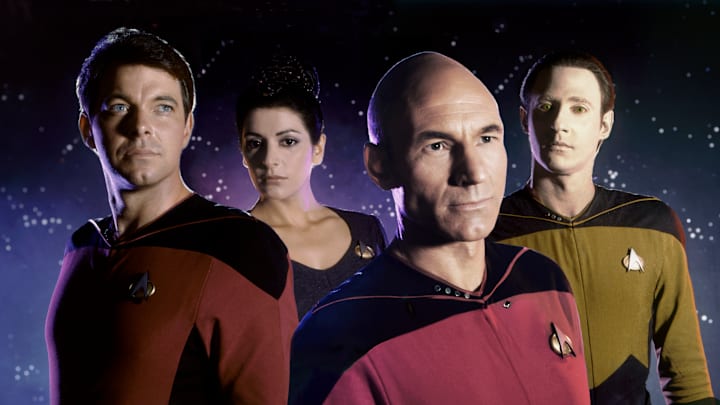Star Trek isn't just about the starships that fly through the cosmos; it's the crews, with their chemistry, bravery, and depth, that make these trips more than just stories and into a galaxy of cultural legend. Star Trek's crews have inspired fans for decades with their ability to lead, work together, and adapt.
Ranking criteria: What makes a great crew?
We looked at each crew's attributes that are important to the spirit of Star Trek:
Team cohesion: How successfully do the members work and grow together?
Leadership: Does the captain inspire people to respect themselves and work well together?
Character development: Do both the main characters and the secondary characters have meaningful arcs and depth?
Mission performance: How does the team handle pressure, change, and challenges?
Diversity and representation: Does the team show a variety of backgrounds and points of view?
5. Enterprise NX-01 (ENT)
Captain Jonathan Archer's NX-01 team is the first of its kind in Starfleet, and you can tell. Archer, who is more enthusiastic than experienced, becomes humanity's first deep-space captain, dealing with new territory and many mishaps. The crew gets along well, although their friendship isn't very polished. Their journey is typically a "first draft" for later starship teams. Episodes like "Detained" show trust growing, yet their early years are full of missteps and doubt.
The crew's importance as Federation forerunners is shown by major storylines like the Xindi conflict. T'Pol (Vulcan) and Phlox (Denobulan) provide the mostly new human crew a much-needed point of view, showing how hard it was for Starfleet to deal with diversity at first. Enterprise's prequel style had a lot of committed fans, but the show didn't always do a good job of developing stories with the whole cast, which made this crew the least memorable on the list.
Why they are fifth: Bold ideas were not well carried out because of problems with group dynamics and lack of expertise.
4. USS Enterprise (TOS)
Captain James T. Kirk is a renowned leader who is brave, entertaining, and likes to break the rules to get things done. The trio of Kirk, Spock, and McCoy make up one of the best TV groups of all time. They philosophically spar and show genuine affection for each other. Even though they weren't always in the spotlight in character-driven stories, the larger crew, Uhura, Sulu, Scotty, and Chekov, pushed the limits on television in the 1960s.
Their "five-year mission" set the standard for every subsequent Trek. The crew of The Original Series became cultural icons because they broke down barriers. They changed not only sci-fi, but also generations of fans and even NASA. But the later series went deeper, developed characters more, and had bigger story goals.
Why they are fourth: They are legendary and important, but later crews demonstrated more maturity, nuance, and depth.
3. USS Voyager (VOY)
Starfleet officers and Maquis rebels who are trapped far from home are brought together by Captain Kathryn Janeway, who leads her crew with intelligence, decisiveness, and a motherly determination. Adversity forces the mixed Voyager crew to form close ties over the course of their 70,000-light-year trek, as demonstrated eloquently in episodes such as "Year of Hell" and "Scorpion," which are both terrific two-parters.
Among Voyager's unique voices are: Seven of Nine, a freed Borg; the Doctor, a sentient hologram; and a resourceful, rebellious crew that challenges and develops as a team. Despite occasionally having an episodic narrative, the show promotes diversity and personal growth.
Why they rank number three: Despite being overtaken by crews with even higher narrative risks and complexity, Voyager is ranked at the top due to their strong family dynamic and tenacity.
2. Deep Space Nine (DS9)
The moral struggle and profound personal development that Captain Benjamin Sisko experiences as he evolves from a reluctant commander to a spiritual and military leader bind the Deep Space Nine space station crew together. The DS9 crew has complicated relationships and struggles thanks to dealing with a galactic war, political instability, and religious upheaval.
DS9 may explore the most adult parts of fandom through serial storytelling, such as trauma, prejudice, faith, and the uncertainty of leadership. The station's mix of Bajoran, Trill, Changeling, and Ferengi points of view makes it the most socially relevant series in Trek.
Why they rank second: DS9’s crew offers unmatched depth and credibility but comes second to the number one's timeless optimism and unity.
1. USS Enterprise-D (TNG)
Captain Jean-Luc Picard is in command of the Federation's flagship, the Enterprise-D. it is the best Starfleet has to offer, when it comes to skill, values, and inspiration. Riker, Data, Troi, Worf, Crusher, and La Forge are all key members of this family. Their lives are all intertwined in an array of trust and growth, as shown in memorable episodes like "The Best of Both Worlds" (another excellent two-parter) and "Family."
The crew of TNG is the most varied ever on TV. There is an android, a Betazoid empath, a Klingon officer, and women in important positions. The show often asks what it means to be a person. TNG altered the way sci-fi TV shows were developed by teaching a new global audience how to be inquiring and hopeful.
Why they’re number one: Enterprise-D’s crew embodies the best of Star Trek: curiosity, hope, and acceptance, making them the most iconic and universally celebrated ensemble in the franchise.
More than just explorers
The best Star Trek teams aren't just people who travel across space; they are families that have been through hard times, differences, and a common vision. Their experiences show us that the bravest boundaries in the galaxy can only be crossed when we work together, feel for each other, and have the bravery to face the unknown.
For more Star Trek content, visit the Redshirts Always Die Facebook and X pages.
